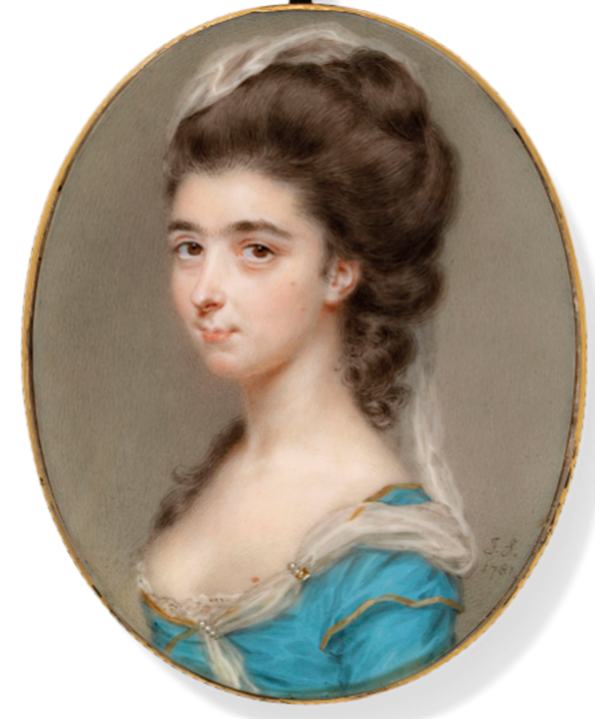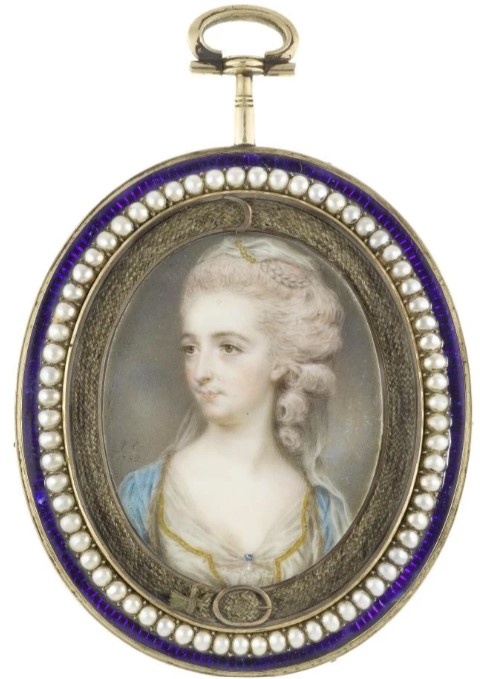Citation
Chicago:
Aimee Marcereau DeGalan, “John Smart, Portrait of a Woman, 1781,” catalogue entry in Aimee Marcereau DeGalan, Blythe Sobol, and Maggie Keenan, The Starr Collection of Portrait Miniatures, 1500–1850: The Collections of the Nelson-Atkins Museum of Art, vol. 4, ed. Aimee Marcereau DeGalan (Kansas City, MO: Nelson-Atkins Museum of Art, 2025), https://doi.org/10.37764/8322.5.1562.
MLA:
Marcereau DeGalan, Aimee. “John Smart, Portrait of a Woman, 1781,” catalogue entry. Aimee Marcereau DeGalan, Blythe Sobol, and Maggie Keenan. The Starr Collection of Portrait Miniatures, 1500–1850: The Collections of the Nelson-Atkins Museum of Art, edited by Aimee Marcereau DeGalan, vol. 4, Nelson-Atkins Museum of Art, 2025. doi: 10.37764/8322.5.1562.
Artist's Biography
See the artist’s biography in volume 4.
Catalogue Entry
This 1781 portrait of an unidentified woman in Turkish-inspired dress offers insight into John Smart’s practice, particularly his reuse of costume elements across multiple works. The woman wears a deep turquoise gown edged in fur, with pearl accents at the shoulders. The gown is layered over a white chemise: A plain, thin white cotton garment with short sleeves and sometimes a low neckline. trimmed in gold, and her hair is piled high and wrapped in a gauzy white veil that cascades over her shoulder. This striking ensemble closely resembles the one worn by Mrs. James Hamilton (née Lucy Lloyd) in a portrait by Smart from the same year (Fig. 1), suggesting that Smart recycled dress details from one sitter to another, likely reflecting the demands of his busy portrait practice.

The choice of dress reflects the broader vogue for à la turque (turquerie): The term “à la turque,” or “Turkish style,” was used throughout the eighteenth and nineteenth centuries to describe a wide range of artistic styles and artforms, from fashion to furniture and even music. For Europeans, the Turkish categorization served as a generalized inspiration for a style perceived as “exotic” and loosely derived from designs sourced from across Turkey and the Middle East. “Turkish” figures in such designs were heavily stereotyped and often sexualized., a fashionable adaptation of Turkish-inspired attire popular in Britain, fueled in part by the writings of Lady Mary Wortley Montagu.1Mary Wortley Montagu, The Turkish Embassy Letters: Lady Mary Wortley Montagu, ed. Malcom Jack (London: Virago, 1994). For a portrait of Montagu, see Sir Godfrey Kneller, Lady Mary Wortley Montagu, ca. 1720, oil on canvas, 35 1/8 x 27 1/4 in. (89.2 x 69.2 cm), Yale Center for British Art, New Haven, CT, B1976.7.191, https://collections.britishart.yale.edu/catalog/tms:394. After she published her account of life in Constantinople in 1763, elements of purportedly Turkish dress permeated British aristocratic fashion and were often adopted for masquerade balls.
For Smart, portraying sitters in turquerie was likely a marketing strategy. A year after painting this portrait, he asked Jane Baldwin (1763–1839), the Turkish-born daughter of a Yorkshire merchant, to sit for him in Turkish dress (Fig. 2). She had recently sat for Sir Joshua Reynolds (1723–1792),2Sir Joshua Reynolds, Mrs. Baldwin in Eastern Dress, 1782, oil on canvas, 55 1/2 x 43 5/16 in. (141 x 110 cm), Compton Verney, Warwickshire, England, CVCSC:0331.B, https://www.comptonverney.org.uk/works/mrs-baldwin-in-eastern-dress. and Smart was eager to follow suit, recognizing the marketing potential of painting a well-known figure in such attire.3In fact, Baldwin inspired two other artists—Smart’s rival, Richard Cosway (1742–1821) and Robert Edge Pine (1730–1788)—to paint her during the period as well. See Hester Lynch Piozzi, Thraliana: The Diary of Mrs. Hester Lynch Thrale, 1776–1809, ed. Katherine C. Balderston (Oxford: Oxford University Press, 1951), 1:530–31. The dress in Smart’s portrait of Baldwin is a variation on the one in the present portrait and the one worn by Hamilton, evidence that a recognizable costume could help to attract clientele.4Piozzi, Thraliana, 1:530–31.

Turkish-inspired dress was more than an aesthetic choice during this period—it was a vehicle for negotiating social mobility and status.5For a deeper discussion on this topic, see Jennifer Ann Van School, “The Indian Cashmere Shawl and Social Status in Art, 1760–1870,” (PhD diss., University College, London, 2019), https://core.ac.uk/download/pdf/333900892.pdf. See also Christine Riding, “Traveller and Sitters: The Orientalist Portrait,” in The Lure of the East: British Orientalist Painting, ed. Nicholas Tromans (London: Tate, 2008). As British society grappled with the effects of industrial progress and global expansion, Turkish dress allowed women to project a sense of exoticism and wealth within the bounds of respectability. Smart’s use of such attire, replicated across different sitters, reflects how portraiture contributed to this complex discourse on status, identity, and Britain’s evolving relationship with the wider world. With this portrait, Smart not only captures the fashionable allure of turquerie but also highlights its significance within the broader cultural and social context of late eighteenth-century Britain.
Notes
-
Mary Wortley Montagu, The Turkish Embassy Letters: Lady Mary Wortley Montagu, ed. Malcom Jack (London: Virago, 1994). For a portrait of Montagu, see Sir Godfrey Kneller, Lady Mary Wortley Montagu, ca. 1720, oil on canvas, 35 1/8 x 27 1/4 in. (89.2 x 69.2 cm), Yale Center for British Art, New Haven, CT, B1976.7.191, https://collections.britishart.yale.edu/catalog/tms:394.
-
Sir Joshua Reynolds, Mrs. Baldwin in Eastern Dress, 1782, oil on canvas, 55 1/2 x 43 5/16 in. (141 x 110 cm), Compton Verney, Warwickshire, England, CVCSC:0331.B, https://www.comptonverney.org.uk/works/mrs-baldwin-in-eastern-dress.
-
In fact, Baldwin inspired two other artists—Smart’s rival, Richard Cosway (1742–1821) and Robert Edge Pine (1730–1788)—to paint her during the period as well. See Hester Lynch Piozzi, Thraliana: The Diary of Mrs. Hester Lynch Thrale, 1776–1809, ed. Katherine C. Balderston (Oxford: Oxford University Press, 1951), 1:530–31.
-
Piozzi, Thraliana, 1:530–31.
-
For a deeper discussion on this topic, see Jennifer Ann Van School, “The Indian Cashmere Shawl and Social Status in Art, 1760–1870” (PhD diss., University College, London, 2019), https://core.ac.uk/download/pdf/333900892.pdf. See also Christine Riding, “Traveller and Sitters: The Orientalist Portrait,” in The Lure of the East: British Orientalist Painting, ed. Nicholas Tromans (London: Tate, 2008).
Provenance
Mr. John W. (1905–2000) and Mrs. Martha Jane (1906–2011) Starr, Kansas City, MO, by 1965;
Their gift to the Nelson-Atkins Museum of Art, Kansas City, MO, 1965.
Exhibitions
John Smart—Miniaturist: 1741/2–1811, The Nelson-Atkins Museum of Art, Kansas City, MO, December 9, 1965–January 2, 1966, no cat., as Lady.
The Starr Foundation Collection of Miniatures, The Royal Ontario Museum, Toronto, December 8, 1972–January 14, 1973, no cat., no. 107, as Unknown Lady.
John Smart: Virtuoso in Miniature, The Nelson-Atkins Museum of Art, Kansas City, MO, December 21, 2024–January 4, 2026, no cat., as Portrait of a Woman.
References
Ross E. Taggart, The Starr Collection of Miniatures in the William Rockhill Nelson Gallery (Kansas City, MO: Nelson Gallery-Atkins Museum, 1971), no. 107, p. 40, (repro.), as Unknown Lady.
No known related works at this time. If you have additional information on this object, please tell us more.